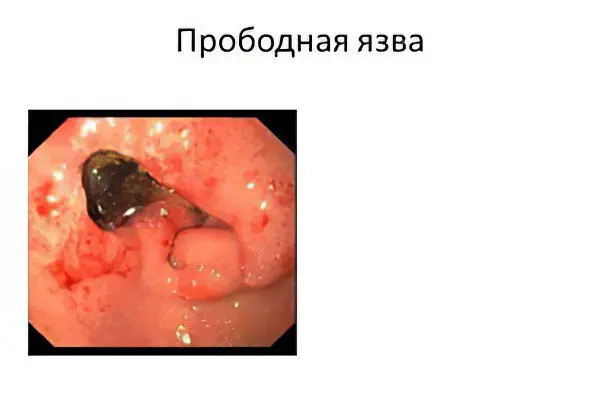Contents
What is a perforated stomach ulcer?
A perforated stomach ulcer belongs to the category of severe, life-threatening diseases. There is a perforation in the wall of the organ and the contents directly flow into the abdominal cavity. As a result, peritonitis develops, which requires immediate intervention by the surgeon.
Currently, in Russia, perforated ulcers are diagnosed in almost 3 million people. Relapses occur in 6% of patients. Men are more susceptible to the disease. The hormone estrogen produced by the female body has a deterrent effect on the activity of the secretory glands of the gastric mucosa.
Causes of a perforated stomach ulcer

People suffering from chronic peptic ulcer disease, as well as those who have had an acute form of the disease, are at risk of a perforated defect.
Perforation can be initiated by:
Inflammation that occurs around the main focus of mucosal damage;
Overeating (stomach can not cope with a large amount of food);
Increased acidity of gastric juice (leads to the appearance of an aggressive environment);
Excessive consumption of spiced food and alcohol;
Sudden physical exertion;
Modern research indicates that the causative agent of peptic ulcer disease is the bacterium Helicobacter pylori (possessing initially aggressive strains). Almost 50% of all mankind are infected with it. But seeding is not the only cause of peptic ulcer disease. Any violation of the protective functions of the body activates the pathogenic influence of microorganisms.
Factors that increase the risk of developing peptic ulcer:
Suppressed state of the immune system;
Violation of the quality or duration of sleep, work in night shifts;
Prolonged stress;
Taking certain medications. Long-term treatment with non-steroidal anti-inflammatory drugs (including aspirin) is not allowed, even short-term anticoagulants (warfarin, heparin), corticosteroids (prednisolone), and some chemotherapy drugs can have a pathogenic effect;
Smoking (has an indirect effect on the increase in the content of hydrochloric acid and the violation of microcirculation in the mucous membranes);
Excessive alcohol consumption (leads to a direct violation of the mucous membranes);
Violation of the diet and quality of food. Too low or high temperature of food, foods with high fat content, smoked meats, etc., eating dry food unnecessarily burdens the stomach and provokes the occurrence of diseases;
Hereditary factors;
The presence of other pathologies of the gastrointestinal tract (for example, gastritis);
Symptoms of a perforated stomach ulcer
A typical form of the course of the disease is accompanied by the ingestion of the contents of the stomach into the free abdominal region.
There are three periods of development:
Period of chemical peritonitis. The duration of the flow in time is from 3 to 6 hours. Depends on the diameter of the hole and the volume of secretions from the stomach. Accompanied by acute pain in the stomach. Severe pain is possible in the paraumbilical segment and in the right hypochondrium. Subsequently, they cover the entire abdomen. Perforation of the anterior wall of the stomach can manifest itself in pain in the region of the left side of the abdomen and left forearm. Pain sensations are characterized by duration of manifestation. Vomiting is rare. Blood pressure is low, but the pulse is usually within normal limits. Breathing becomes shallow and rapid. The skin turns pale, sweating increases. The muscles of the anterior part of the abdomen are tense, an accumulation of gases is observed in the abdominal cavity.
period of bacterial peritonitis. Begins 6 hours after perforation. The abdominal muscles relax, breathing becomes deeper and sharp pains disappear. The person feels relieved. In this phase, there is an increase in temperature, an increase in heart rate and a further change in blood pressure. A period of increasing toxicity begins, which leads to an increase in the volume of gases, paralysis of peristalsis. The tongue becomes dry, with a gray coating on the anterior and lateral surfaces. The general behavior of the patient changes. He experiences euphoria and relief, becomes uncritical to his condition, does not want to be disturbed. If during the period of increased intoxication no emergency medical care is provided, then the person goes to the third, most severe stage of the disease.
The period of acute intoxication. It begins, as a rule, after 12 hours from the moment of illness. The main manifestation is indomitable vomiting, leading to dehydration. Visually, changes in the skin can be noted. They become dry. There is a sharp drop in body temperature. An increase to 38°-40° is replaced by a decrease to 36,6°. The pulse reaches 120 beats per minute. Upper arterial pressure drops to 100 mm Hg. The general condition of the patient is characterized by lethargy, indifference, delayed reaction to external stimuli. There is an increase in the abdomen due to the accumulation of free gas and liquid. The process of urination is disturbed, eventually stops completely. If a person has reached this phase of development of peritonitis, then it is almost impossible to save his life.
Classification of perforated ulcer

According to the clinical course of the disease:
Typical shape. It is characterized by the leakage of the contents of the stomach into the abdominal cavity;
atypical form. The contents enter the omentums or omental bag, leakage into the retroperitoneal tissue or the interadhesion area is possible;
Perforation with bleeding into the abdominal cavity or gastrointestinal tract;
According to the stages of development of peritonitis:
Stage of primary pain shock;
Stage of development of bacterial peritonitis, accompanied by contamination by microorganisms;
The stage of the inflammatory process, accompanied by feelings of imaginary well-being;
The stage of a severe course of the disease, accompanied by the occurrence of purulent peritonitis;
According to pathological and anatomical features:
Perforation of a chronic ulcer (a complication of peptic ulcer);
Perforation of an acute ulcer;
Perforation in case of damage to the wall of a hollow organ by a tumor formation;
Perforation in parasitic diseases;
The occurrence of a defect due to a violation of local blood circulation;
According to the localization of the focus:
Gastric ulcer (anterior, posterior wall, lesser or greater curvature);
Duodenal ulcer;
Pyloroduodenal ulcer;
Combined ulcer (stomach and duodenum);
Methods for diagnosing a perforated ulcer
Perforation is characterized by an attack of sharp, sudden pain. If there is a history of peptic ulcer, gastritis, etc., then the task is facilitated. As a rule, a differential method is used for diagnosis.
It consists in examining the body, taking into account the presence / absence of the following pathologies:
Acute appendicitis;
Acute cholecystitis;
Perforation of tumor formations;
hepatic colic;
Acute pancreatitis;
Thrombosis;
Dissecting abdominal aortic aneurysm;
myocardial infarction;
Lower lobe pneumonia;
Pleurisy;
Pneumothorax;
Additional research methods are:
X-ray. The efficiency of diagnosing the filling of the abdominal cavity with air reaches 80%. But a similar picture can also be observed in the case of intestinal airiness or atony of the fallopian tubes;
Electrogastroenterographic. Allow to make a qualitative analysis of the evacuation function of the stomach and duodenum;
Endoscopy. It is used for negative results of x-ray studies, but if perforation is suspected. Allows you to determine the presence of peptic ulcer, the localization of the focus. The study is carried out by pumping air, which helps to determine the true clinical picture;
Complete blood count (shows an increased content of leukocytes);
Laparoscopy. Helps qualitative and quantitative analysis of effusion in the abdominal cavity. Has contraindications for use;
Laparoscopy is not used if the patient has:
Obesity;
Adhesions in the abdomen;
Violation of the integrity of the diaphragm;
Pathology of blood clotting;
The presence of large hernias on the anterior wall of the peritoneal region;
General serious condition;
Treatment of perforated stomach ulcer

Perforated ulcers are treated surgically. Preoperative preparation consists in the removal of gastric contents and the restoration of blood pressure. A study is also being carried out to select further actions.
Evaluated by:
Time elapsed since the onset of the disease;
Nature of origin, size and localization of the ulcer;
The severity of peritonitis and the area of its distribution;
Age characteristics of the patient;
Presence/absence of additional pathologies;
Technical features of the hospital and the level of professionalism of doctors;
Separate organ-preserving operations (suturing) and radical (resection, excision of ulcers, etc.).
Sewing of a perforated hole is indicated in the presence of widespread peritonitis, high surgical risk (associated with the presence of concomitant pathologies or the age of the patient), and the absence of an ulcer history in young people. The technique consists in excising the edges of the ulcer and then suturing them with two rows of sutures. With this method of solving the problem, the shape of the organ and the diameter of its lumen are preserved. At the end of the operation, temporary drains are installed. Further treatment with antiulcer drugs is prescribed.
Resection of the stomach
Resection of the stomach is an operation that leads to the loss of a significant part of the organ. After transferring it, disability is established. Indications are the presence of chronic, large-diameter ulcers, suspicion of malignant tumors, the patient’s age is less than 65 years in the absence of concomitant pathologies in the decompression period, the development of acute inflammation and purulent peritonitis, 6-12 hours after the onset of the disease.
In the absence of peritonitis, suturing the wall of the perforated hole can be performed in combination with selective proximal vagotomy.
Excision of an ulcer with the use of stem vagotomy and pyroplasty is used in the presence of an ulcer of the pyloric stomach, a combination of perforation with bleeding, stenosis.
Lack of surgical intervention necessarily leads to death in the coming weeks after the development of the disease.
Diet after gastric perforation surgery
The first rule for recovery and reducing the risk of relapse is strict adherence to the doctor’s instructions. The exception to the rule “if you can’t, but really want to” does not work. In the postoperative period, a strict diet is established. It can last from 3 to 6 months. The diet becomes more difficult gradually.
The basic principles of the diet:
The daily number of meals is up to 6 times, in small portions.
All products taken should be puree or semi-liquid.
Cooking food should be steamed or boiled
Salt should be taken in limited quantities
You should also limit the intake of simple carbohydrates (sugar, chocolate, pastries) and liquids.
On the 2nd day after the operation, mineral water, fruit jelly, weak, slightly sweetened tea are allowed to be taken.
After 2-3 days, the diet is replenished with rosehip broth, pureed soups and cereals from rice and buckwheat. Vegetable soups-puree from boiled carrots, pumpkins, zucchini, potatoes or beets. It is allowed to take a soft-boiled egg and steamed soufflé from mashed cottage cheese.
On the 10th day after the operation, mashed boiled carrots, pumpkins, zucchini or potatoes are introduced into the diet. Steam cutlets, soufflés, mashed potatoes, quenelles, meatballs or zrazy from lean meats or fish are gradually introduced. Cheesecakes, puddings, cottage cheese casseroles are added. You can also use fresh grated cottage cheese. In addition, whole milk and non-acidic dairy products (acidophilus, yogurt, matsoni) are introduced.
Only after a month it becomes possible to receive bread products: dryers, stale bread, crackers.
After 2 months, it is allowed to add fresh sour cream to food and consume kefir.
What can not be eaten with a perforated stomach ulcer?
With a perforated stomach ulcer, you can not eat the following foods:
Offal
Fatty meat and fish
Brees
Sweet pastries
Spicy, smoked, salty, spicy dishes
Smoked meat
Canned food
mushrooms
pulse
Marinades
Sauces
Jam
Honey
Chocolate and cocoa
Ice cream
sparkling water
Alcohol
Vegetables with coarse fiber (cabbage, spinach, pepper, radish, radish, sorrel, turnip).
As the condition improves after surgery for a perforated ulcer, the diet can be expanded with new dishes from meat, vegetables, cereals and dairy products. All canned, spicy and smoked foods are excluded.









